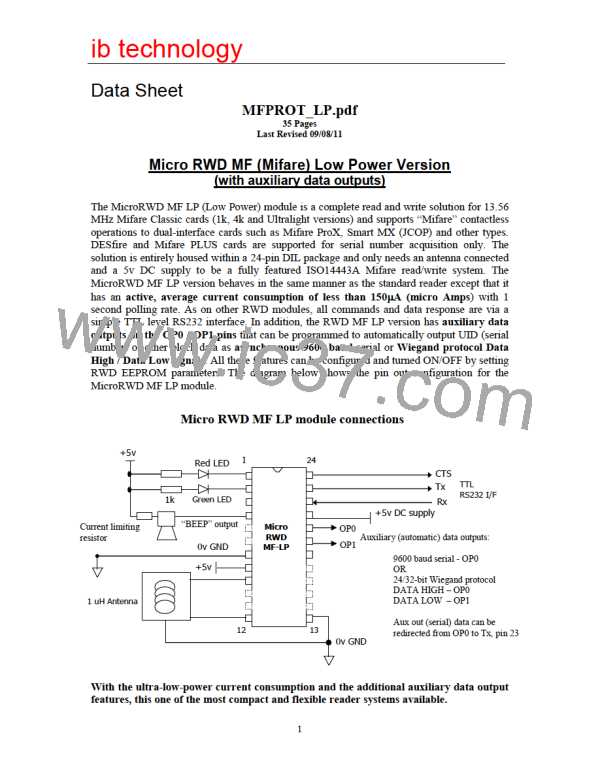ib technology
For a polling technique, the host computer would then keep sending the “STATUS” or
“CARD UID” command and would monitor the acknowledgement code until a valid Mifare
card was detected.
For the interrupt technique, the Green LED output can be used as an interrupt signal
connected to the host computer. The Green LED output is normally high and goes low only
when a valid card has been detected. This falling-edge signal can trigger a host interrupt to
then send the “STATUS” or “CARD UID” command to determine the card type and serial
number.
In both cases once a valid card has been detected a “READ BLOCK” or “WRITE BLOCK”
command can be sent and the acknowledge code monitored to establish that the operation was
successful.
Method of Operation
The system works on a polling principle whereby the RF field is turned on for a short period
to check if a card is present. Authentication and Read/Write operations can then be performed
before the RF field is turned off again and the process repeats. The polling principle where the
RF is off most of the time allows for low average power consumption.
When a Mifare card is detected in the field a multi-pass handshaking procedure takes place
where card information and serial number data is exchanged and checked for integrity. Once
this procedure has completed successfully an individual card has been selected and is
available for other operations.
The RWD itself has the additional feature of then checking the four byte Mifare UID/serial
number (or least significant four bytes of Ultralight UID) against an internal authorisation list.
The RWD internal EEPROM contains a list of four byte Identity codes (up to 60 of them)
located from byte 12 onwards. If the list has FF FF FF FF (hex) stored at the first location
(EEPROM bytes 12 - 15) then the list is treated as empty so the Identity code check is
skipped.
Otherwise the card serial number is checked against all the entries in the list (until the FF FF
FF FF termination code is reached) and if matched then the RWD allows the card to be
accessed for other operations. If not the Red LED remains on and the card is blocked for
further access. This is an additional level of security that can be used as a “mini access
control” system for simple applications that only involve the serial number or where the
Security Keys are not known.
Once the RWD has selected the card and has matched the serial number against it’s internal
list (or the list is empty) then the Read/Write (or Inc/Dec/Transfer) operations can be
performed. These require an internal high-security Authentication Crypto algorithm to take
place that use the supplied Security Keys to gain access to a particular sector. If the Key
selected does not match the Key stored in the Mifare card sector then the operation fails and
the Red LED is turned on again.
So in summary, a card can be successfully selected but can be blocked by the RWD
authorisation list and fail Read/Write operations because the Keys are incorrect. Even if the
Security Key is incorrect the Serial number can still be read using the “Card UID” command.
20

 RFSOLUTIONS [ RFSOLUTIONS.LTD ]
RFSOLUTIONS [ RFSOLUTIONS.LTD ]